Referring back to the diagram of space needs, begin finalizing the plan by refining the spaces into definite shapes. Now you are ready to choose materials. Try to choose materials that satisfy as many of your need as possible.
This includes any potential impact on the environment (i.e. drainage and runoff, energy conserving construction materials, etc.)
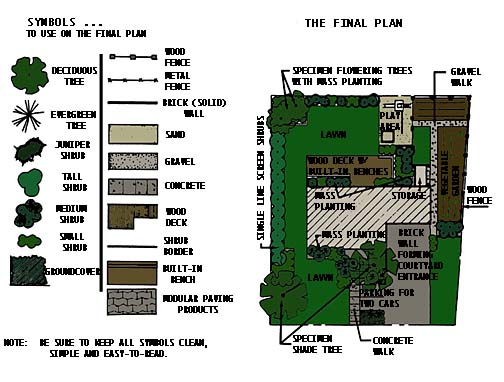
Visual Barriers

Sometimes non-living materials such as fences are a better choice than living materials such as a hedge. Both materials should provide privacy, but the hedge may require considerable time to grow where the fence provides immediate privacy. Also, if space is limited a fence may be the best solution. Maintenance is also frequently a concern. Usually non-living materials (brick, wood, etc.) require less maintenance than living materials which may require watering, trimming, etc.
One of the major objectives of good landscaping is to create a visual relationship between the house and the site. If your house is already constructed, you can still do a fine job of relating it to the site. Some of the ways this relationship between house and site may be achieved are:
- Use plants that are found growing naturally on or near the site. These plants are often extremely “resource efficient”, requiring little in the way of supplemental irrigation or fertilizer/pesticide applications.
- Repeat architectural lines of the house in the landscape – either with plants or construction such as walls, fences, etc.
- Use building materials that blend well in the natural environment or may be found there (for example: a wood shingle roof for a home on a wooded site or stone retaining walls in an area where the stone is found naturally). These construction materials often work well in combination with resource efficient landscapes.
- Landscape design cannot be reduced to a series of rules. It may, however, be helpful for the homeowner to keep the following design concepts in mind as the design develops.
Group Plants for Emphasis
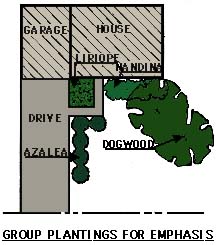
Group the same plants rather than alternating shrubs or using many individual plants spotted about the property to provide a sense of unity and order.
This technique will also assist in hydrozoning (grouping plants with like water requirements) the landscape.
Plant Trees for Shade
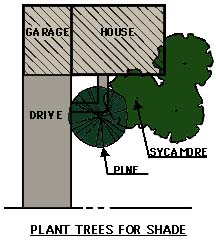
Trees of appropriate mature size should be used so that they will be neither too large nor too small for the house. Deciduous trees can usually be planted closer to the home than evergreens.
Proper placement of trees in the landscape can lower energy consumption for heating and cooling while reducing costly utility bills. Plan carefully to take advantage of this aspect of the design.
Complement the Structure
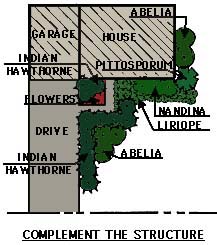
Do not separate the house from its site by a ring of plants or foundation planting. Plants should compliment the lines of the structure, not set it apart from the site.
Provide Privacy
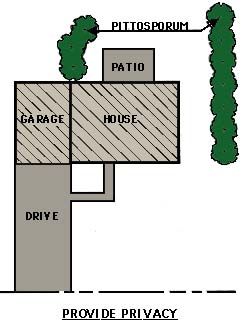
Instead of planting all the way around the property lines of your site, place screen plantings where they will provide privacy to exposed traffic and neighborhood activity. Use screening materials only where necessary.
Soften Walks and Drives

Walks and drives in most cases serve only as aids in circulating people. When they are lined with hedges, border grass or other materials, they may become too prominent. Use enough materials to soften large areas of paving but allow the lawn grass to meet the pavements in most areas.
Allowing Space for Ultimate Growth
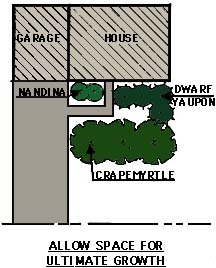
Space shrubs in relation to buildings to allow for natural growth. Generally, no shrub should be placed closer than three feet from the building unless it is a groundcover or a plant which uses the wall for support. Do not be fooled by small plants in the nursery. Know the mature size of all plants you are using and space them accordingly. Plants should compliment, not cover a house. Select plants that require less maintenance.
See the Earth-Kind Plant Selector for size specifications and detailed information on culture and care.
Screen Service Areas

Service areas should require small amounts of the site. Clothes lines, garbage containers, tool storage, etc. should be placed in a convenient area and screened from the living and viewing areas of the landscape.
This area may also include a location for composting bins, piles or other material/equipment for managing yard wastes.
Use Native and Well Adapted Plants
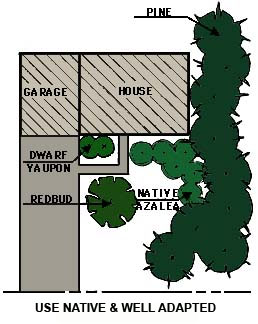
These selections do better at withstanding weather extremes, require less supplemental irrigation and are usually more resistant to insects and diseases than non-adapted plants.
Native plants can be important relating a structure to its site.
Use the Earth-Kind Plant Selector to find plants that are HIGHLY ADAPTED to your specific location. Plants with an Earth-Kind Index of 8 or above are considered extremely resources efficient.

